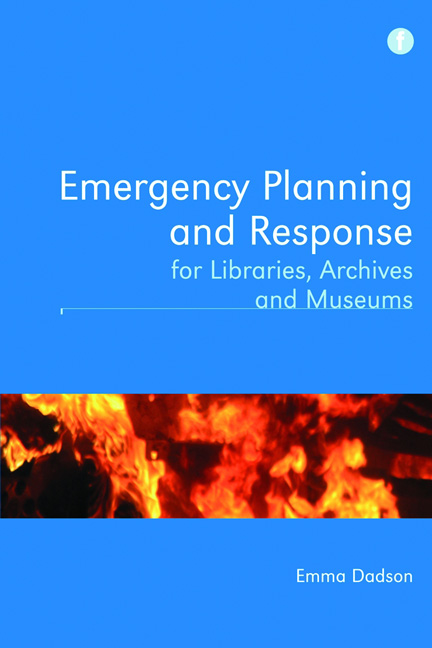Book contents
- Frontmatter
- Contents
- Foreword
- Preface
- Acknowledgements
- 1 Introduction
- 2 Case studies
- 3 Roles and responsibilities
- 4 Incident control
- 5 Planning the recovery operation
- 6 Collections salvage
- 7 Supplementary content
- 8 Dealing with the building
- 9 Business continuity
- 10 Ensuring the plan's efficacy
- 11 Conclusion
- Bibliography and references
- Index
- Frontmatter
- Contents
- Foreword
- Preface
- Acknowledgements
- 1 Introduction
- 2 Case studies
- 3 Roles and responsibilities
- 4 Incident control
- 5 Planning the recovery operation
- 6 Collections salvage
- 7 Supplementary content
- 8 Dealing with the building
- 9 Business continuity
- 10 Ensuring the plan's efficacy
- 11 Conclusion
- Bibliography and references
- Index
Summary
In this chapter a variety of case studies highlight the importance of preparedness and the potential severity of the challenges in emergency response situations, and how particular problems have been overcome in the planning process. They emanate from libraries, archives and museums from around the globe, which have faced incidents including earthquakes, fires and floods. Their experiences and learning points convey the reason why the emergency planning content outlined in this book is essential.
CASE STUDY: Flood recovery at the State Library, Queensland, Australia
Grant Collins, Linda Barron and Rory McLeod, State Library of Queensland, Australia
Context
At 4 pm on Tuesday 11 January 2011, the State Library of Queensland's clients and staff evacuated the building after days of torrential rain had fallen in the regional catchments of SouthEast Queensland resulting in flood waters rising from the Brisbane River. The State Library of Queensland (SLQ) is located directly adjacent to and overlooks the Brisbane River. The river levels rose to 4.46 metres resulting in the basement level of the State Library being inundated. The Counter Disaster Plan (CDP) was implemented with relocation of collections from the basement to upper building levels before the building evacuation.
Much of the Brisbane Central Business District (CBD) and lowlying river areas were inundated; this included the State Library's loading dock, which was covered by 1.9 metres of river water. The State Library building was closed for a month while the car park was closed for several months. This led to significant disruption while recovery was carried out to power substations, the river pump room, the State Library of Queensland loading dock, lower level staff areas, audiovisual store, cold storage vaults, quarantine facility and the suite of general storerooms all located on the lower level (see Figure 2.1). From 7 February, staff made a graduated return to the building to prepare for a ‘soft’ opening to the public on 16 February and a full publicized opening for the weekend of 19–20 February.
Once flood waters reduced it was clear that this was a disaster that had affected the building infrastructure and library services to clients became a business continuity challenge. Having a detailed and tested Business Continuity Plan (BCP) was our greatest asset.
- Type
- Chapter
- Information
- Publisher: FacetPrint publication year: 2012



